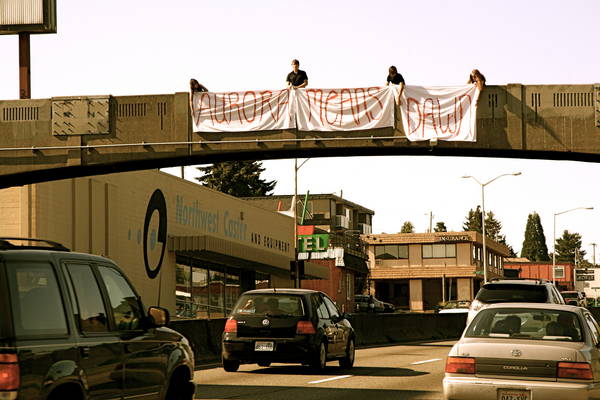Recently, a group of MHGS students creatively responded to the pain and brokenness of their neighborhood through an artistic expression. Blaine Hogan, an MHGS grad from the Christian Studies program, wrote a thoughtful response on his own blog about the project (reposted here).
What does it look like to respond creatively to the needs of your community? What does the Gospel look like smack dab in the middle of a broken community? Some friends of mine in Seattle are answering these questions and setting a beautiful example for us all.
 If you take Aurora and head north of downtown, you are swiftly slapped in the face by the countless cockroach motels, run-down storefronts, adult entertainment venues, prostitution “Watch Area” signs, and the Aurora Bridge, where over 200 hundred people have jumped to their death since its construction in 1932.
If you take Aurora and head north of downtown, you are swiftly slapped in the face by the countless cockroach motels, run-down storefronts, adult entertainment venues, prostitution “Watch Area” signs, and the Aurora Bridge, where over 200 hundred people have jumped to their death since its construction in 1932.
If you were to drive this painful stretch of road these days you might notice something new – bed sheets flapping about in the misty Seattle rain.
In response to the hurt they were witnessing in the neighborhood, a group of current and former students of Mars Hill Graduate School (my alma mater) began working on a public art project. White sheets with red messages of hope, declaration, and protest read: “Sex is Beautiful,” “Life is Beautiful,” and “Aurora Means Dawn.” The group stationed one sheet on a corner in front of The Voyeur (an adult bookstore), and the other two were hung from the infamous Aurora bridge, and an overpass welcoming drivers into the area.
In addition to the sheets, the group I listed the other day, Urban Hymnal, created a music and performance-art experience they called, The Bridge, the Corner, and the Dawn, which focused on themes of sexual exploitation, addiction, suicide, and hope.
As I read about the story, I was struck more by what my friends didn’t do.
With a blank slate and a captive audience, they could have responded however they pleased. And yet, instead of a Christian music concert, they created an experience that spoke specifically to their context. Instead of messages of condemnation and contempt, they wrote messages of hope and redemption.
May we all take note: THIS is how you respond to your community.
Some thoughts to consider:
- Are you listening to your community?
- Are you aware of what it needs?
- Do you know where it is hurting?
- Are you willing to admit you don’t yet know?
- Do you have a process for gleaning this information?
- Once you have listened, how will you respond?


